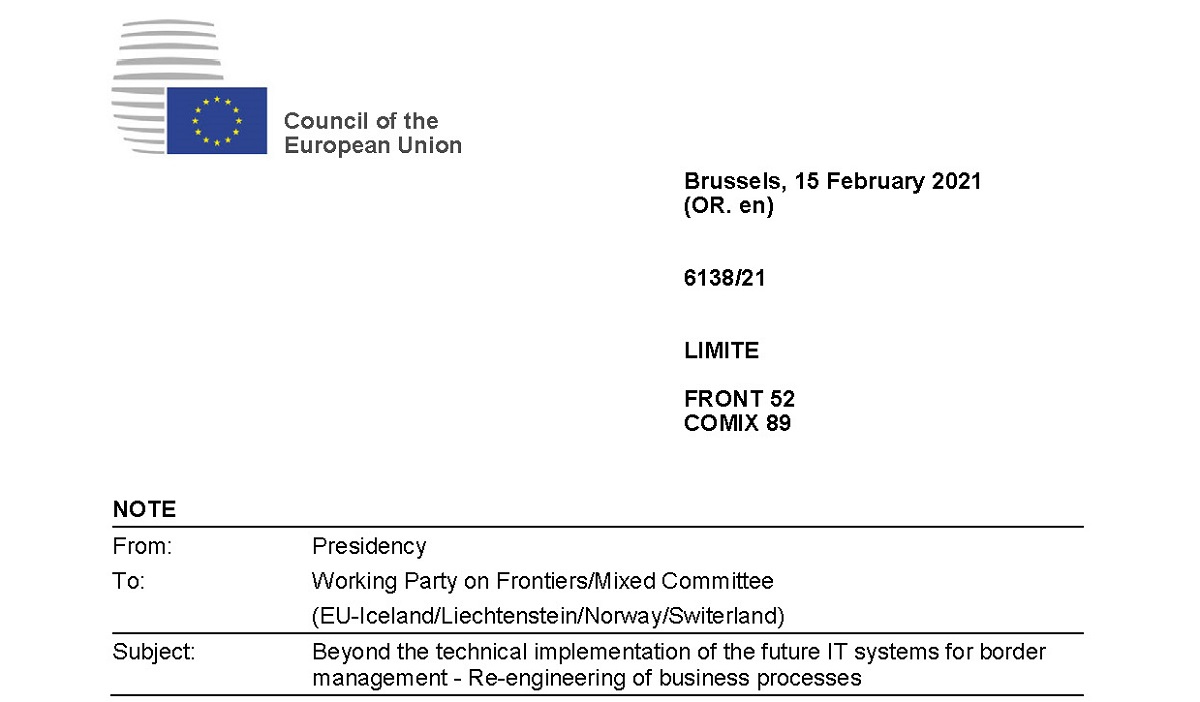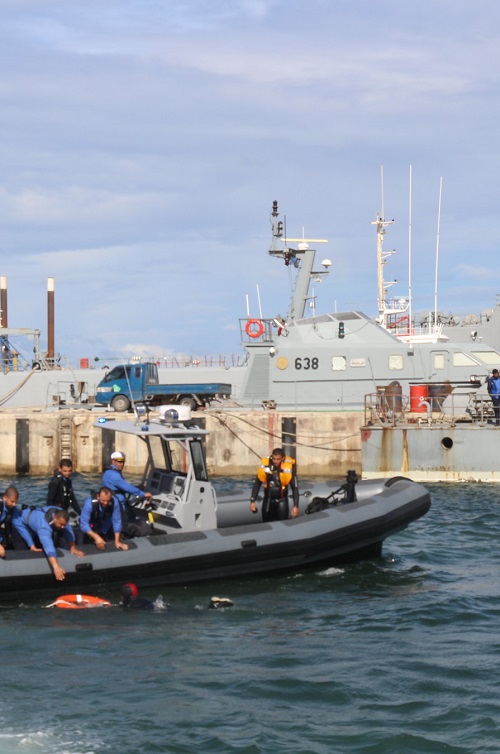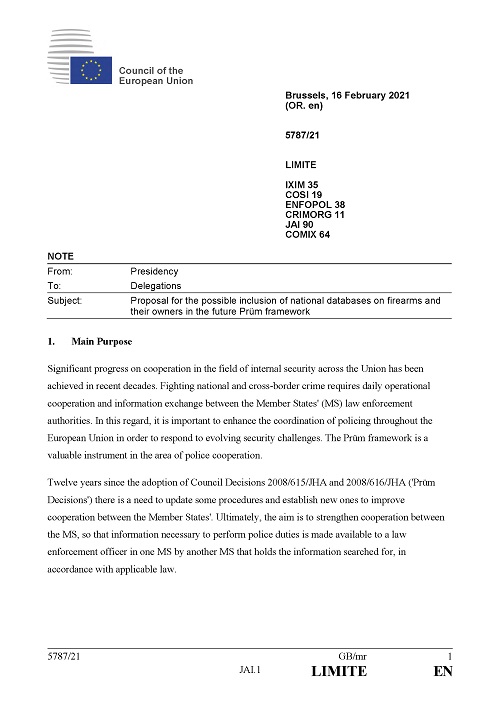EU: New databases and information systems: "a paradigm shift in the area of border management"
Topic
Country/Region
03 March 2021
"The new architecture for EU information systems for borders, migration and security will completely change the way in which border control and other related activities will be carried out," says a document from the Portuguese Presidency of the Council.
Support our work: become a Friend of Statewatch from as little as £1/€1 per month.

The Presidency is seeking information from the member states on how to prepare the ground for implementing new border control systems.
For the moment the focus is on:
- the Entry/Exit System (EES), which will create a centralised database of all border crossings by non-EU citizens and residents entering or leaving the Schengen area, and generate automatic alerts on 'overstayers';
- the European Travel Information and Authorisation System (ETIAS), through which visa-exempt non-EU citizens will have to make an application to travel to the EU (see our report Automated Suspicion for a detailed overview).
However, the Presidency underlines that these two systems are merely the beginning of a bigger "paradigm shift in the area of border management" introduced by the "interoperability" of EU databases.
The Presidency's paper is concerned with the effect of these new systems on the work of border guards and police officers - but what about the effects of these systems on the people with whom those officials come into contact?
See: Beyond the technical implementation of the future IT systems for border management - Re-engineering of business processes (Council document 6138/21, LIMITE, 15 February 2021, pdf, all emphasis added):
"...the EU has launched an initiative to develop and deploy a new information architecture for internal security and border management. In this regard, the Entry Exit System (EES) (and the targeted amendments of the ‘Schengen Border Code’ as regards the use of the EES that accompany the EES Regulation) and the European Travel Information and Authorisation System (ETIAS) will join other national, EU and international IT systems already available at external borders. This document focuses on the EES and ETIAS as they are among the first new IT systems of the new information architecture for internal security and border management which are due to enter into operation in the first and the second half of 2022 respectively. However, any discussion on the re-engineering of business processes also needs to continue beyond the EES and ETIAS. The reason is that, in the longer term, changes stemming from other recently adopted, or still to be adopted legislation, will continue to affect the work of border guards.
The new information architecture for internal security and border management also reflects a paradigm shift in the area of border management away from physical and manual operations to increasingly digital and automated operations, and away from a silo-based approach with regard to IT systems to interoperable systems to ensure a more efficient access to the right information by the right authorities at the right time. The ultimate objective of the new IT architecture is, for instance, to effectively support the processes that the border guards have to execute at the external borders."
"The implementation of the EES and its interoperability with the VIS - adapting to the way the border checks will be performed when the EES is used at external borders and adding to the requirements for checking ETIAS at external borders - are therefore not just a technical initiative. In order that both systems deliver the anticipated policy objectives and operational benefits, their technical implementation will be coupled with efforts to redesign the relevant operational processes followed by the Member States. The aim is to ensure a smooth and efficient integration of the new capabilities provided by the systems within the daily work of border guards. This, in turn, will ensure the implementation of an integrated border management strategy at operational level."
"Overall, these projects are extremely challenging. The reasons include the novelty of the approaches, the multitude of stakeholders involved, the different responsibilities of the stakeholders and the cross-sectoral impact. One of the most important elements is that as a result of the EES and ETIAS, and with the implementation of interoperability, new operational business processes will need to be in place. These will cover the activities of the National Authorities and the Union Agencies involved in all associated business areas. Such areas include visa, border and immigration authorities, law enforcement authorities, industry (Carriers operating in all areas) and the ETIAS National Units."
"The main EES processes (use cases) can be used as an example to illustrate the complexity of the Member State’s tasks in redesigning / re-engineering the above business processes. The processes relevant to border authorities in the context of the EES include: border checks, biometric management at the border, offline mode (with National Uniform Interface - NUI available) and fall-back procedures - including manual stamping and notification of the European Commission should the NUI be unavailable. Moreover, the business processes should take into consideration the specific nature of each type of border (land, air, sea), the categories of travellers concerned, whether the case concerns a first or a subsequent entry or exit and the various facilitation means used (e.g. ABC gates). Furthermore, there is a need to redesign the processes used by the immigration authorities (verification within the territory), visa authorities (examination and processing of visa applications), and law enforcement access (via Central Access Points - CAP). The processes related to data amendment and business continuity aspects should also be redesigned."
"The new architecture for EU information systems for borders, migration and security will completely change the way in which border control and other related activities will be carried out. In view of this and the novelty of such developments, it is essential that there is a close collaboration between all stakeholders on all matters related to the implementation of these projects."
"So as to support Member States’ efforts and share best practices, the Presidency considers this a good opportunity to hold an exchange of views among the Member States’ experts. There is a need to focus on national experience in terms of ongoing preparations as well as any specific steps taken and analysis carried out with a view to the re-engineering of business processes.
Therefore, in view of the Frontiers Working Party meeting scheduled on 3 March 2021, the Member States are invited to provide their input on the following questions:
-
- What is the approach taken at national level concerning the redesign of the current business processes or the creation of new ones, where applicable?
- What are the major challenges encountered? If any, how are they being overcome?
- How could Member States be better supported by the European Commission, eu-LISA, other Agencies or other Member States through the sharing of ideas and approaches with regard to the process of redesign?
- Would Member States consider it appropriate that eu-LISA prepare a Paper identifying the associated use cases for the EES and ETIAS, to support the work of Member States?"
Our work is only possible with your support.
Become a Friend of Statewatch from as little as £1/€1 per month.
Spotted an error? If you've spotted a problem with this page, just click once to let us know.

